The Center for China and Asia-Pacific Studies, in collaboration with the Diplomatic Academy of Peru and the Shanghai Institute for International Studies (SIIS), held the international conference China and Asia-Pacific in Globalization: Trends and Challenges, at the Diplomatic Academy's headquarters on September 20. The keynote speaker at the event was Dr. Chen Dongxiao, president of the SIIS.
The other speakers were Minister José Bustinza, director of APEC and specialized forums at the Peruvian Ministry of Foreign Affairs; Dr. Niu Haibin, deputy director of the Center for American Studies and assistant director of the SIIS Institute for International Strategic Studies; and Dr. Rosario Santa Gadea, Director of the Center for China and Asia-Pacific Studies of the Universidad del Pacífico.
During the opening of the event, Minister Marisol Agüero, deputy director of the Diplomatic Academy of Peru; and Dr. Cynthia Sanborn, vice chancellor of the Universidad del Pacífico, gave the welcoming remarks.
Chinese diplomacy in a world in transition
Dr. Chen Dongxiao's speech was structured around three key questions. First, how does China see recent changes in the world order, especially in relation to globalization? Second, how have these changes influenced Chinese diplomacy? And finally, what are the implications of these changes for Sino-Latin American relations?
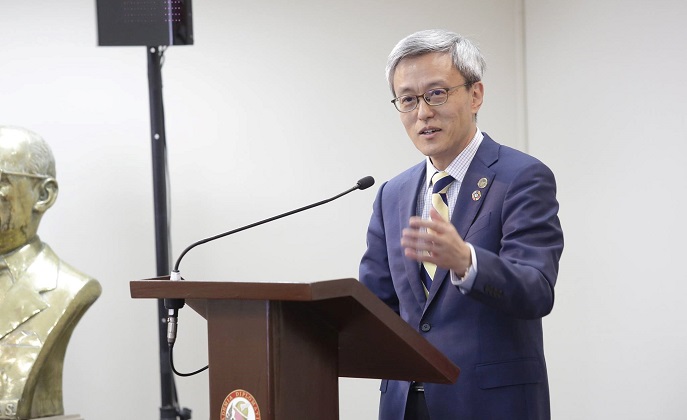
Dr. Chen Dongxiao speaking at the conference.
Changes in globalization.
Dr. Chen argued that the world has entered a new historical cycle characterized by great instability and uncertainty. Instability between great powers is on the rise. Likewise, efforts to improve global governance have not translated into significant progress. Meanwhile, uncertainty between medium and small countries has also increased. Non-traditional threats such as climate change put humanity as a whole at risk. Added to this, the rise of populism in developed economies has eroded international relations in economic and security terms.
Chinese foreign policy
Given these global trends, Chinese foreign policy under President Xi Jinping has been marked by continuity and change. Thus, the premier has maintained four basic principles of Chinese diplomacy: a single China, cooperation, responsibility between major powers, and noninterference in internal affairs. But he has also developed a fifth principle of building a "community with a shared destiny for humanity", to show that China seeks to "build a regional and world order based on peace, cooperation and win-win".
To counter growing uncertainty and global instability, Chinese diplomacy seeks to build strategic partnerships around the world – in place of traditional military alliances – and face the challenges of globalization together. The country is also looking to participate actively in global governance, taking on greater international responsibilities. To this end, China has launched the Belt and Road Initiative as a new form of integration based on interconnectivity to unite the Silk Road Economic Belt (overland routes) and the 21st-century Maritime Silk Road (sea routes).
China and Latin America
Although China and Latin America are geographically distant, "both have a common desire for peace and prosperity." Notwithstanding the global reconfiguration of power, both see the welfare of their population as a top priority. This has led to closer cooperation between China and Latin America at the political, economic and social levels, and initiatives such as the Belt and Road serve to consolidate this process.
A vision of APEC post 2020
Minister José Bustinza focused his presentation on APEC's efforts to renew its vision beyond 2020. The world today is very different from that of 1989, the year of APEC's foundation, so there is a need to renew the organization's medium- and long-term goals and consider how these might be achieved.
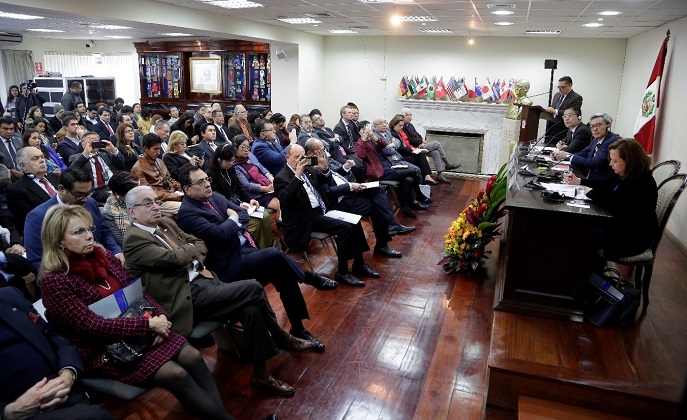
Minister Bustinza during his presentation at the conference.
In 1994, the APEC forum adopted the Bogor Goals, which committed leaders of the member economies to turning the region into "a free and open area in terms of the flow of goods, services and investments for developed economies by 2010, and for the remaining members by 2020." At the 2017 APEC summit in Vietnam, member economies agreed to renew APEC's vision and establish 2030 as a target by which to realize the associated goals.
The APEC Vision Group, drawing on eminent figures from the public sector, academia and/or the business world, was set up to work until 2020. There is a consensus that the forum's new vision should be centered on people; that is, that economic growth and inclusion must aspire toward human well-being and prosperity.
China's contribution to globalization
Dr. Niu Haibin considers it important that the benefits of globalization reach more people so as to lend it more legitimacy while staving off the rise of populism. Thus, there is a need for new consensuses around development issues. In these terms, he regards initiatives such as the 2030 Agenda of the United Nations as vital. Moreover, he stated that "new and better ideas are needed to manage relations between the great powers, especially that between China and the United States; the problems that exist in the bilateral relationship cannot be resolved unilaterally."
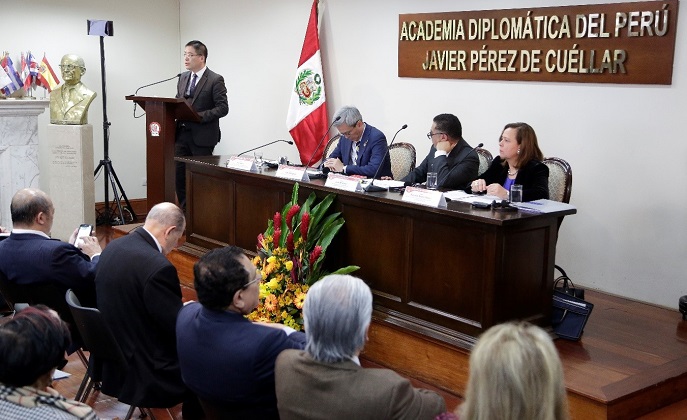
Dr. Niu Haibin, giving his comments.
Externally, a notable example of China's contribution to a more legitimate globalization is its greater provision of public goods, through the likes of the Belt and Road Initiative and the Asian Infrastructure Investment Bank. On the domestic front, China continues to open itself up to the world, integrating more and more into the world economy and focusing on quality economic growth: that is, based on higher social and environmental standards. In this way, it seeks to contribute not only to more but also better world growth.
The Belt and Road Initiative in Peru
For her part, Dr. Rosario Santa Gadea centered her comments on the Belt and Road Initiative. She noted that although this initiative tends to be thought of as nothing more than a plan for China to invest in infrastructure, in actual fact it is a comprehensive economic integration program. Dr. Santa Gadea argued that Peru is better positioned than other Latin American countries to place the Belt and Road on its cooperation agenda with China. However, exactly how to implement the initiative remains a matter for debate.
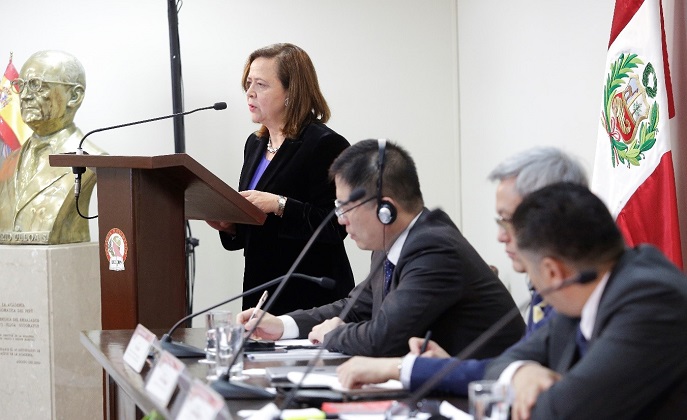
Dr. Rosario Santa Gadea during her presentation at the conference.
In this regard, she stressed that connectivity with China is the crux of the initiative and so should be at the center of coming infrastructure efforts, and not necessarily Peru's infrastructure gap as a whole. Geographically located at the center of the Pacific coast of South America, "Peru has the conditions to become a hub of international trade between both sides of this rim, particularly between China and South America. This would involve building a trans-Pacific economic corridor between China and our region, with Peru as the point of connection on our side of the Pacific."
In sum, Peru should first define a strategic vision; second, design a trans-Pacific economic corridor; and third, assess its viability. The government, the business sector, and academia ought to contribute to this effort by way of a long-term vision. Finally, she remarked that the current international context strengthens emphasis on the Pacific Rim as a dynamic zone in the 21st century. The world GDP share of the 15 Pacific Rim economies in Asia and Oceania grew from 23% in 2000 to 33% in 2017, which China accounting for 18% of that total. Thus, she concluded, close involvement with this grouping is of great interest to Peru.
Visit to Universidad del Pacifico and meeting with the rector
On September 20 the president of the SIIS and his delegation met with the rector of the Universidad del Pacífico, Dr. Elsa Del Castillo, to discuss future collaboration possibilities. It should be noted that Universidad del Pacífico and SIIS signed a memorandum of understanding on March 2017, which has thus far proven very satisfactory.
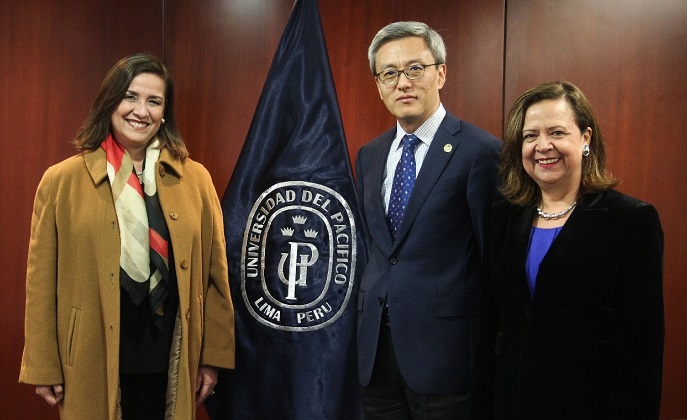
Elsa Del Castillo, rector of the UP, Dr. Chen Dongxiao, president of the SIIS and Dr. Rosario Santa Gadea, Director of the Center for China and Asia-Pacific Studies of the UP.